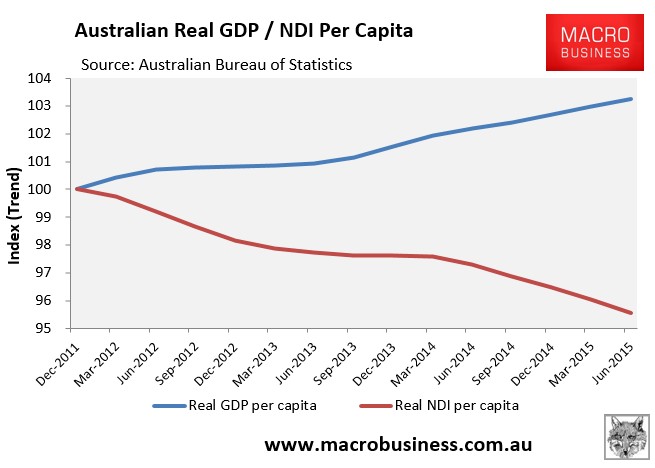Two years ago I questioned whether the liquified natural gas (LNG) boom would actually benefit Australians, who would be forced to endure rising domestic gas prices as most of the bounty from LNG exports flowed offshore:
With a “gas cliff” expected in 2016 as major east coast LNG export terminals come on line, gas shortages and rising domestic prices are likely to become more pressing. One can only wonder whether for every dollar earned from exporting gas to Asia, Australia faces losing much more in lost value-added local production.
With oil prices now in the gutter, the LNG situation is playing-out even worse than expected for Australians, with the $200 billion worth of Australian LNG projects currently under construction unlikely to even turn a profit, according to the International Energy Agency (IEA). From The AFR:
The agency said even if oil prices recovered and averaged $US60 a barrel for the next few years, Australia’s LNG industry – one of the world’s biggest – will struggle to be profitable.
“In a $US60 oil environment the Australian projects will continue, but you are probably not breaking even,” the IEA’s senior gas expert, Costanza Jacazio, said in an interview from Paris. “Will anything else in Australia proceed beyond this next portion of projects? I think in this environment it is very unlikely”…
Singapore-based energy forecaster Fereidun Fesharaki said the economics of the planned LNG projects in Australia are a “tragedy” due in part to over-optimistic expectations that Asian buyers would continue to pay historically high prices.
“I am looking at oil to average a maximum of $US75 a barrel over the next decade, and even then they just won’t get a rate of return to justify the investment,” said Dr Fesharaki, a former energy adviser to the prime minister of Iran who has close links with Asian LNG buyers.
Australia’s ginormous LNG white elephants are a classic example of why Australia’s real GDP and national disposable income (NDI) are diverging:

Real GDP, which does not concern itself with price effects, is being supported by the rise in commodity export volumes.
However, shipping more volumes that make less profit does not lift economic welfare. On the contrary, it destroys it as standards of living decline with falling income.
Add in the fact that in Australia’s case, the LNG boom comes with an added input price shock in the form of a rising gas price that will hurt both manufacturing and households, and the LNG boom becomes a real millstone around our collective necks.
Indeed, last year Victoria University modelling showed that the east coast would be better off without the LNG boom into the future.
According to Victoria University, any volume gains from the LNG boom counted in GDP are offset by the income falls resulting from high gas prices crowding out other sectors like manufacturing, big utility price increases for eastern households, as well as the profits mostly flowing offshore to the foreign owners. And given national income is a much better measure of economic welfare than GDP, the LNG boom actually reduces Australians welfare.

